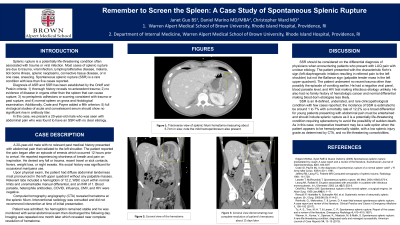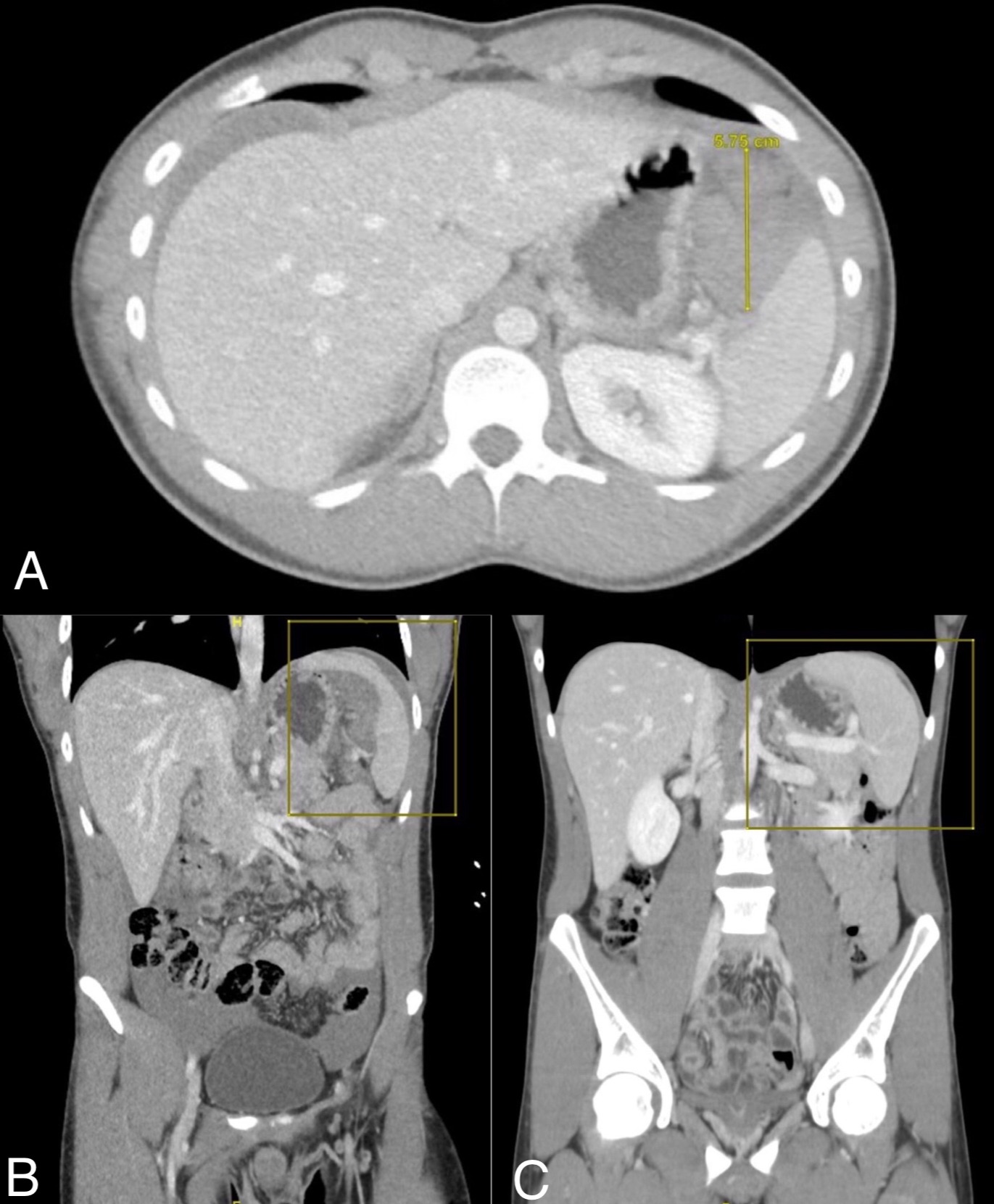Back


Poster Session E - Tuesday Afternoon
Category: GI Bleeding
E0329 - Remember to Screen the Spleen: A Case Study of Spontaneous Splenic Rupture
Tuesday, October 25, 2022
3:00 PM – 5:00 PM ET
Location: Crown Ballroom

Has Audio

Janet Guo, BS
Brown University
Providence, RI
Presenting Author(s)
Janet Guo, BS1, Daniel Marino, MD, MBA2, Christopher Ward, MD1
1Brown University, Providence, RI; 2Warren Alpert Medical School of Brown University, Providence, RI
Introduction: Splenic rupture is a potentially life-threatening condition often associated with trauma or viral infection. Most cases of splenic rupture are due to trauma, viral infection, lymphoproliferative disease, malaria, tick borne illness, splenic neoplasms, connective tissue disease, or in one case, sneezing. Spontaneous splenic rupture (SSR) is a rare condition with less than five cases reported. In this case, we present a 20-year-old male who was seen with abdominal pain who was found to have an SSR with no clear etiology.
Case Description/Methods: A 20-year-old male with no relevant past medical history presented with abdominal pain that radiated to the left shoulder. The patient reported the pain began after an episode of emesis which occurred 12 hours prior to arrival. He reported experiencing shortness of breath and pain on inspiration. He denied any fall or trauma, recent travel or sick contacts, fevers, weight loss, or night sweats. His social history was significant for occasional marijuana use. Upon physical exam, the patient had diffuse abdominal tenderness most pronounced in the left upper quadrant without any palpable masses. Relevant labs included a hemoglobin of 12.2, WBC count within normal limits and unremarkable manual differential, and an INR of 1. Blood parasite, heterophile antibodies, COVID, influenza, CMV, and HIV were negative. Computed tomography angiography (CTA) revealed hematoma at the splenic hilum. Interventional radiology was consulted and did not recommend intervention at time of initial presentation. Patient was admitted; his hemoglobin remained stable and he was monitored with serial abdominal exam then discharged the following day. Imaging was repeated one month later which revealed near complete resolution of hematoma.
Discussion: SSR should be considered on the differential diagnosis of physicians when encountering patients who present with LUQ pain with unclear etiology. The patient presented with the characteristic Kehr’s sign (left diaphragmatic irritation resulting in referred pain to the left shoulder) but not the Ballance sign (palpable tender mass in the left upper quadrant). The incidence of SSR is estimated to be around 1 to 7% with a mortality rate of 12.2% so a broad differential for young patients presenting with abdominal pain must be entertained and should include splenic rupture as it is a potentially life-threatening condition.

Disclosures:
Janet Guo, BS1, Daniel Marino, MD, MBA2, Christopher Ward, MD1. E0329 - Remember to Screen the Spleen: A Case Study of Spontaneous Splenic Rupture, ACG 2022 Annual Scientific Meeting Abstracts. Charlotte, NC: American College of Gastroenterology.
1Brown University, Providence, RI; 2Warren Alpert Medical School of Brown University, Providence, RI
Introduction: Splenic rupture is a potentially life-threatening condition often associated with trauma or viral infection. Most cases of splenic rupture are due to trauma, viral infection, lymphoproliferative disease, malaria, tick borne illness, splenic neoplasms, connective tissue disease, or in one case, sneezing. Spontaneous splenic rupture (SSR) is a rare condition with less than five cases reported. In this case, we present a 20-year-old male who was seen with abdominal pain who was found to have an SSR with no clear etiology.
Case Description/Methods: A 20-year-old male with no relevant past medical history presented with abdominal pain that radiated to the left shoulder. The patient reported the pain began after an episode of emesis which occurred 12 hours prior to arrival. He reported experiencing shortness of breath and pain on inspiration. He denied any fall or trauma, recent travel or sick contacts, fevers, weight loss, or night sweats. His social history was significant for occasional marijuana use. Upon physical exam, the patient had diffuse abdominal tenderness most pronounced in the left upper quadrant without any palpable masses. Relevant labs included a hemoglobin of 12.2, WBC count within normal limits and unremarkable manual differential, and an INR of 1. Blood parasite, heterophile antibodies, COVID, influenza, CMV, and HIV were negative. Computed tomography angiography (CTA) revealed hematoma at the splenic hilum. Interventional radiology was consulted and did not recommend intervention at time of initial presentation. Patient was admitted; his hemoglobin remained stable and he was monitored with serial abdominal exam then discharged the following day. Imaging was repeated one month later which revealed near complete resolution of hematoma.
Discussion: SSR should be considered on the differential diagnosis of physicians when encountering patients who present with LUQ pain with unclear etiology. The patient presented with the characteristic Kehr’s sign (left diaphragmatic irritation resulting in referred pain to the left shoulder) but not the Ballance sign (palpable tender mass in the left upper quadrant). The incidence of SSR is estimated to be around 1 to 7% with a mortality rate of 12.2% so a broad differential for young patients presenting with abdominal pain must be entertained and should include splenic rupture as it is a potentially life-threatening condition.

Figure: A. Transverse view of splenic hilum hematoma measuring about 5.7cm in size; note the mild hemoperitoneum also present.
B. Coronal view of the hematoma.
C. Coronal view demonstrating near complete resolution of patient's hematoma about 15 days later.
B. Coronal view of the hematoma.
C. Coronal view demonstrating near complete resolution of patient's hematoma about 15 days later.
Disclosures:
Janet Guo indicated no relevant financial relationships.
Daniel Marino indicated no relevant financial relationships.
Christopher Ward indicated no relevant financial relationships.
Janet Guo, BS1, Daniel Marino, MD, MBA2, Christopher Ward, MD1. E0329 - Remember to Screen the Spleen: A Case Study of Spontaneous Splenic Rupture, ACG 2022 Annual Scientific Meeting Abstracts. Charlotte, NC: American College of Gastroenterology.
